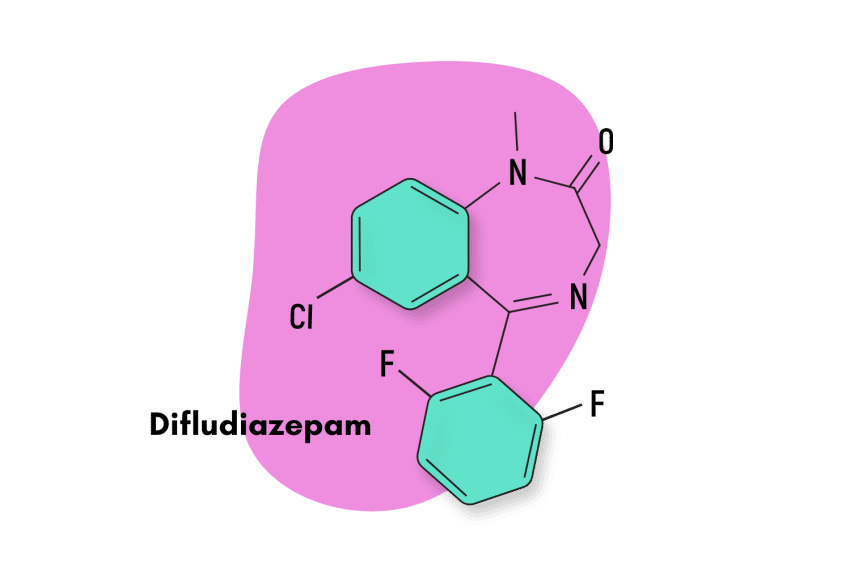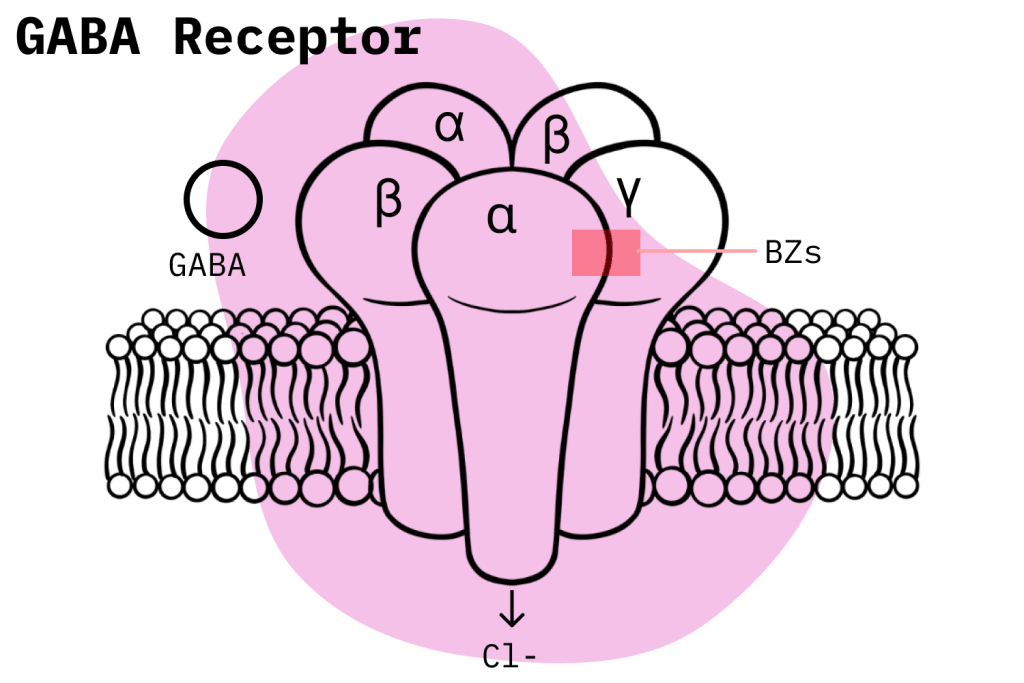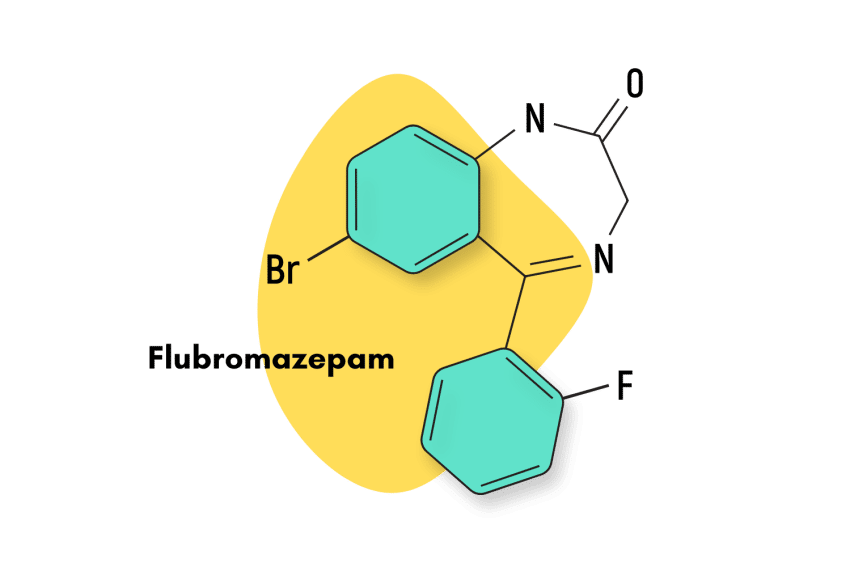Difludiazepam: Fact Sheet & Harm Reduction Guide

Difludiazepam, also known as RO07-4065, is the 2,6-difluoro derivative of fludiazepam, one of the most potent benzodiazepines currently in existence.
In the case of difludiazepam, adding another fluoride group to the chemical structure is believed to significantly improve bioavailability — thus making this compound even more powerful.
Difludiazepam has been sold online as a designer drug since at least 2017 after Swedish authorities submitted a report to the EU early warning system.
Evidence suggests that difludiazepam’s parent compound, fludiazepam, has been abused since the ’90s. Due to fludiazepam’s extreme potency, the recreational use of this compound can be very dangerous. Just a little bit too much can lead to significant side effects.
Difludiazepam Specs
| Status | Research Chemical |
| Common Dosage | Not specified |
| PubChem ID | 44366236 |
| CAS# | 39080-67-6 |
IUPAC Name: 7-chloro-5-(2,6-difluorophenyl)-1-methyl-3H-1,4-benzodiazepin-2-one
Other Names: RO07-4065
Metabolism: The metabolism of difludiazepam has not been meaningfully studied.
Duration of effects: Unspecified.
Benzodiazepine Dosage Equivalency Calculator
**Caution:** Benzodiazepines have a narrow therapeutic window. Dose equivalents may not be accurate in higher doses.
This calculator does not substitute for clinical experience and is meant to serve only as a reference for determining oral benzodiazepine equivalence.
Please consult a medical practitioner before taking benzodiazepines.
How Does Difludiazepam Work?
Difludiazepam exerts its effects by binding to the benzodiazepine site of the gamma-aminobutyric acid-A (GABA) receptors in the brain and central nervous system (CNS). Once bound, difludiazepam enhances GABA-mediated synaptic inhibition.
In simple terms, difludiazepam significantly boosts the effects of GABA in the brain — causing widespread inhibition of brain activity. This effect reduces anxiety, fear, and worry in lower doses and brings on full sedation and amnesia in higher doses.
Research has shown that difludiazepam’s extreme potency is partly a result of its exceptionally high binding affinity for GABA-A receptors.
This enhanced binding capacity is thought to result from halogenated groups at the ortho position of the phenyl ring [1].
More research is needed to fully understand this compound’s true potency and safety profile.

Is Difludiazepam Safe? Risks & Side Effects
It’s hard to make any definitive statements regarding difludiazepam since there are no studies that directly attempt to assess its risk level. However, given what we know, we can still draw some general conclusions.
The shared pharmacological nature of most benzodiazepines means they all share a considerable baseline risk. Usually, they are regarded as relatively safe compounds when taken responsibly (i.e., when there is no misuse). However, once we add the very real possibility of drug abuse and incorrect dosages, the risk level rises considerably. And when it comes to difludiazepam, there are two extra factors to consider: its extreme potency and the fact that it’s only available illegally.
Designer benzodiazepine use has a high likelihood of being recreational, and even when it’s not, it’s still happening without the guidance of a licensed doctor. For this reason, designer benzodiazepine use is always inherently riskier. And when you factor in difludiazepam’s extreme potency, then the picture starts looking quite dangerous.
Side Effects of Difludiazepam
Difludiazepam’s side effects profile has not been studied. However, an official report from the Advisory Council on the Misuse of Drugs states that difludiazepam has a high degree of structural similarity to diazepam, which has been thoroughly studied.
Therefore, we can use diazepam’s side effect profile as a good baseline for estimating the side effects of difludiazepam.
The FDA label for diazepam lists the following side effects:
- Antegrade amnesia
- Anxiety
- Blurred vision
- Changes in libido
- Changes in salivation
- Confusion
- Constipation
- Depression
- Diplopia
- Dizziness
- Drowsiness
- Dysarthria
- Elevated transaminases and alkaline phosphatase
- Fatigue
- Gastrointestinal disturbances
- Hallucinations
- Headache
- Hypotension
- Incontinence
- Insomnia
- Irritability
- Muscle weakness
- Nausea
- Skin reactions
- Slurred speech
- Tremors
- Urinary retention
- Vertigo

Benzodiazepine research suggests that compounds with high potency and high affinity for GABA-A receptors, like difludiazepam, have an increased rate of adverse effects. This means that even though difludiazepam likely shares in diazepam’s side effects, the risk is much higher.
Benzodiazepine Withdrawal & Dependence
Benzodiazepine dependence is much more of a possibility than common knowledge would suggest. Many people, even benzodiazepine users, believe that dependence can only occur due to an abnormally long treatment duration or some form of drug abuse.
But the data suggests this is a misconception.
For example, a recent study that examined the likelihood of developing a benzodiazepine dependence after four weeks concluded that over one-third of participants had withdrawal symptoms upon cessation [2].
Regarding some of the higher potency benzodiazepines, the FDA often suggests that these compounds shouldn’t be used for more than seven to 10 consecutive days as it risks the possibility of dependence. In the case of difludiazepam, we don’t have any individual studies to fall back on. Still, it is a generally accepted truism that the more potent the benzodiazepine, the more liable it is to cause dependence.
Recreational users of difludiazepam should do their best to limit both the quantity they’re consuming and how often they are doing so: limiting these two factors is the most effective strategy for hedging against the risk of dependence. Additionally, users who take benzodiazepine regularly should not try to suddenly discontinue their use. Going “cold turkey” can risk the appearance of nasty withdrawal symptoms, which, on rare occasions, can even be lethal.
Harm Reduction: Difludiazepam
Benzodiazepine Harm Reduction Tips:
- 🥣 Don’t mix — Mixing benzodiazepines with other depressants (alcohol, GHB, phenibut, barbiturates, opiates) can be fatal.
- ⏳ Take frequent breaks or plan for a short treatment span — Benzodiazepines can form dependence quickly, so it’s important to stop using the drug periodically.
- 🥄 Always stick to the proper dose — The dosage of benzos can vary substantially. Some drugs require 20 or 30 mg; others can be fatal in doses as low as 3 mg.
- 💊 Be aware of contraindications — Benzodiazepines are significantly more dangerous in older people or those with certain medical conditions.
- 🧪 Test your drugs — If ordering benzos from unregistered vendors (online or street vendors), order a benzo test kit to ensure your pills contain what you think they do.
- 💉 Never snort or inject benzos — Not only does this provide no advantage, but it’s also extremely dangerous. Benzos should be taken orally.
- 🌧 Recognize the signs of addiction — Early warning signs are feeling like you’re not “yourself” without the drug or hiding your habits from loved ones.
- ⚖️ Understand the laws where you live — In most parts of the world, benzodiazepines are only considered legal if given a prescription by a medical doctor.
- 📞 Know where to go if you need help — Help is available for benzodiazepine addiction; you just have to ask for it. Look up “addiction hotline” for more information about where you live. (USA: 1-800-662-4357; Canada: 1-866-585-0445; UK: 0300-999-1212).
Difludiazepam Drug Interactions
Benzodiazepine users should be aware of mixing compounds that have a depressive effect on the CNS. These combinations potentiate the depressive effect exerted on the nervous system exponentially and can easily lead to severe respiratory depression, the leading cause of death among drug overdoses.
Indeed, the recent explosion in polydrug abuse in the United States has led to a steep rise in benzodiazepine-related deaths and should serve as a stark warning for anyone who engages in this behavior.

Difludiazepam Contraindications
The shared GABA-mediated pathway of virtually all non-atypical benzodiazepines means they also share the same contraindications.
Benzodiazepine-related contraindications include:
- Bronchitis
- Chronic obstructive pulmonary disease (COPD)
- Conjunctive use of barbiturates, opiates, or those suffering from alcoholism
- Intellectual disabilities due to frequent paradoxical reactions
- Lactation
- Major depression
- Myasthenia gravis
- Over the age of 65 (high risk)
- Personality disorders
- Pregnancy
- Sleep apnea

Similar Benzodiazepine Alternatives
Despite a lack of formal research on difludiazepam, there are quite a few user reports outlining the subjective effect profile of this drug. Unfortunately, most of these reports contradict each other — some users claim it’s much more euphoric, others say it’s a strong sedative, and some state it even has mild psychedelic properties.
The truth is that this compound is so strong even very subtle differences in dose, individual metabolic factors, or diet can affect how this drug feels.
With that aside, the most similar compounds in terms of structure and shape include fludiazepam and diazepam.
The effects of difludiazepam are similar to many of the other popular benzodiazepines, including — alprazolam, brotizolam, bretazenil, etizolam, bromazepam, lorazepam, chlordiazepoxide, clonazolam, and various others.
Let’s explore the differences and similarities of difludiazepam’s closest relatives:
Fludiazepam (Erispan)
Fludiazepam is the benzodiazepine from which difludiazepam is derived. As such, they share many structural and pharmacological traits, with the main difference being increased potency on the part of difludiazepam.

Diazepam (Valium)
Fludiazepam is itself the 2ʹ-fluoro derivative of diazepam (AKA Valium) and is also known to share a similar effects profile.
In fact, both fludiazepam and difludiazepam can be considered derivatives of diazepam, which is why they largely share in their effects profile. However, diazepam is of much lower potency when compared to these two compounds.

Natural Alternatives to Benzodiazepines
Are you looking for a benzodiazepine-like product with a safer overall profile? If so, then you should give natural compounds like kava (Piper methysticum), or the kratom (Mitragyna speciosa) plants a try.
These plant-based alternatives don’t elicit all of the effects you get from benzodiazepines, and they’re certainly not as potent. Still, in many cases, they can be just as good at providing effective relief. And all while presenting a significantly more benign side effects profile and a reduced risk of dependence.

Difludiazepam FAQs
What benzodiazepine subtype does difludiazepam belong to?
Because of its immense potency, it is often assumed that difludiazepam is a triazolobenzodiazepine, but this is not the case. Difludiazepam is a traditional 1,4-benzodiazepine.
What is the IC50 value of difludiazepam?
The IC50 value of difludiazepam is 4.1 nM [3].
References
- Manchester, K. R., Waters, L., Haider, S., & Maskell, P. D. (2022). The blood-to-plasma ratio and predicted GABAA-binding affinity of designer benzodiazepines. Forensic Toxicology, 1-8.
- Riss, J., Cloyd, J., Gates, J., & Collins, S. (2008). Benzodiazepines in epilepsy: pharmacology and pharmacokinetics. Acta neurologica scandinavica, 118(2), 69-86.
- So, S. S., & Karplus, M. (1996). Genetic neural networks for quantitative structure-activity relationships: improvements and application of benzodiazepine affinity for benzodiazepine/GABAA receptors. Journal of medicinal chemistry, 39(26), 5246-5256.








